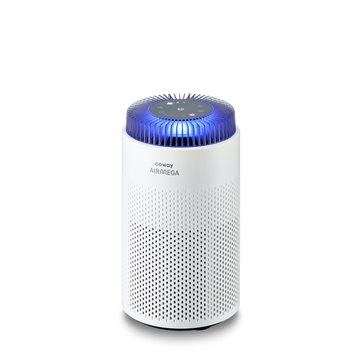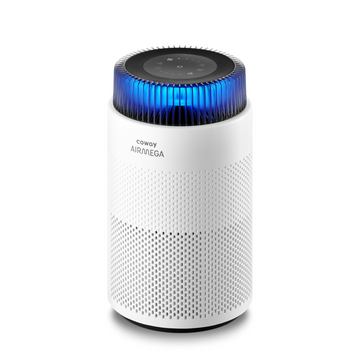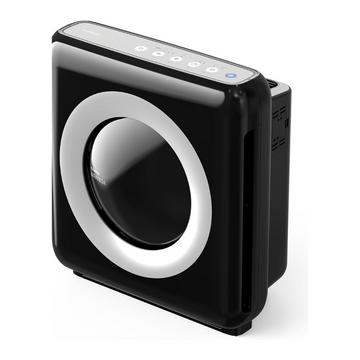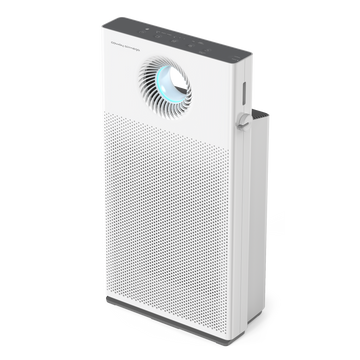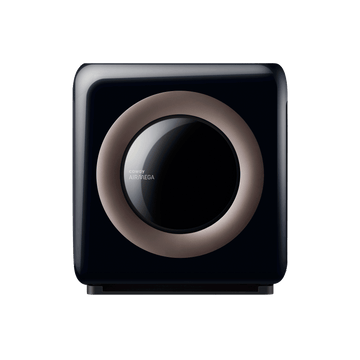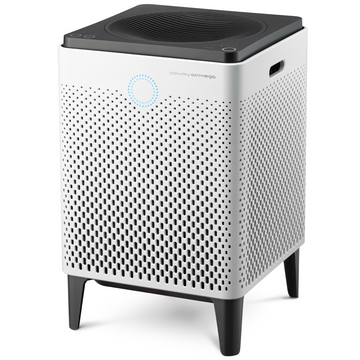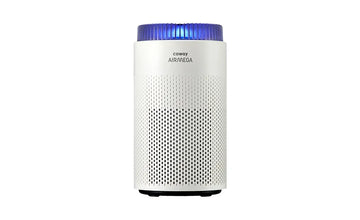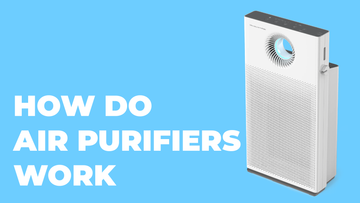Have you ever wondered why the air inside your home sometimes feels stuffy or triggers your allergies, even when everything looks clean? The answer lies in the invisible world of indoor air pollutants. An air purifier is a device designed to clean the air in your home by removing harmful particles, allergens, and contaminants that you can't see but definitely feel.
Indoor air quality has become increasingly important, especially as we spend approximately 90% of our time indoors. According to the EPA, indoor air can be 2-5 times more polluted than outdoor air, making air purification not just a luxury but a necessity for many households.
Key Takeaways
-
Air purifiers are devices that remove contaminants from indoor air using various filtration technologies, primarily HEPA filters that capture 99.97% of particles as small as 0.3 microns
-
They work by drawing air through multiple filters including pre-filters, HEPA filters, and activated carbon filters to trap pollutants, allergens, and odors
-
Major benefits include allergy relief, improved sleep quality, reduced asthma triggers, and elimination of harmful airborne particles like dust, pollen, and pet dander
-
Proper usage involves strategic placement in high-traffic areas, regular filter maintenance, and choosing the right size for your room
-
Modern air purifiers from Coway offer smart features, energy efficiency, and comprehensive filtration for healthier home environments
What Is an Air Purifier?
An air purifier, also known as an air cleaner,is an electrical appliance that removes contaminants from the air in a room to improve indoor air quality. These devices work continuously to filter out microscopic particles that can affect your health, comfort, and overall well-being.
Think of an air purifier as your home's respiratory system – just as your lungs filter the air you breathe, an air purifier filters the air in your living space. The device pulls in contaminated air, processes it through multiple filtration stages, and releases clean, purified air back into your room.
Coway Air Purifier
Core Components of an Air Purifier
Modern air purifiers consist of several essential components working in harmony:
The fan system creates airflow by drawing contaminated air into the device and pushing clean air back out. The filtration system – the heart of any air purifier – typically includes multiple filter types each targeting different pollutants. The housing unit contains all components and often includes controls, indicators, and smart features for optimal operation.
What Do Air Purifiers Do?
Air purifiers serve as your home's dedicated air cleaning system, actively working to remove harmful particles and contaminants that float invisibly through your indoor environment. These devices draw in room air through a powerful fan system, then push it through multiple filtration stages that capture different types of pollutants. The primary functions include:
-
Removing allergens like pollen, dust mites, and pet dander that trigger allergic reactions and asthma symptoms
-
Capturing particulate matter including PM2.5 and PM10 particles from outdoor pollution, cooking, and household activities
-
Eliminating odours from pets, cooking, smoke, and household chemicals through activated carbon filtration
-
Reducing biological contaminants such as mould spores, bacteria, and some viruses that can affect respiratory health
Beyond these core functions, air purifiers create a cleaner breathing environment that particularly benefits those with respiratory conditions, allergies, or anyone living in areas with poor outdoor air quality. By continuously cycling and cleaning the air—typically achieving 4-5 complete room air changes per hour—these devices maintain consistently healthier indoor air quality. The result is not just cleaner air, but often improved sleep quality, reduced allergy symptoms, and less dust accumulation on surfaces throughout your home.
 How Does an Air Purifier Work? The Science Behind Clean Air
How Does an Air Purifier Work? The Science Behind Clean Air
Understanding how air purifiers work helps you appreciate their value and choose the right model for your needs. The process is surprisingly sophisticated yet elegantly simple.
The Filtration Process Explained
When you turn on an air purifier, the internal fan begins drawing air from your room into the device. This contaminated air first encounters the pre-filter, which captures larger particles like hair, dust bunnies, and visible debris. This initial stage protects the more delicate filters that follow.
Next, the air moves through the HEPA (High-Efficiency Particulate Air) filter – the gold standard in air purification. HEPA filters use a complex web of fibers to trap particles through three mechanisms:
-
Interception: Particles following the airflow stick to fibers
-
Impaction: Larger particles collide directly with fibers
-
Diffusion: Ultra-small particles move erratically and eventually hit fibers
After HEPA filtration, many purifiers include an activated carbon filter that absorbs gases, odors, and volatile organic compounds (VOCs) through a process called adsorption. Some advanced models, like those in Coway's air purifier collection, incorporate additional technologies such as ionizers or UV-C light forenhanced purification.
 Understanding CADR and ACH Ratings
Understanding CADR and ACH Ratings
Important Note: When evaluating air purifier effectiveness, two key metrics matter most:
CADR (Clean Air Delivery Rate) measures how quickly an air purifier can clean the air in a specific room size. Higher CADR numbers indicate faster, more efficient purification. The rating is typically given for three particle types: smoke (smallest), dust (medium), and pollen (largest).
ACH (Air Changes per Hour) indicates how many times the purifier can filter the entire room's air volume in one hour. For optimal results, look for purifiers that can achieve 4-5 air changes per hour in your room size.
Signs That Your Room Needs an Air Purifier
Your indoor environment often provides clear signals when air quality is compromised, though some indicators are more subtle than others. Understanding these signs helps you recognize when intervention might improve your health and comfort.
Here are the key warning signs to watch for:
1. Visible dust accumulation appears faster than usual on surfaces, even with regular cleaning. If you notice dust settling on furniture within days of cleaning, or dust particles floating visibly in sunbeams, your room likely has excessive airborne particulates. This becomes particularly concerning when:
-
Dust builds up around air vents and electronics
-
You see a grey film on surfaces near windows
-
Dust bunnies form quickly under furniture
2. Persistent odours that won't dissipate suggest your room harbors trapped pollutants. Unlike temporary smells that clear with ventilation, these odours linger because particles causing them remain suspended in the air. Pay attention to musty smells indicating possible mould, pet odours that persist despite cleaning, or chemical scents from cleaning products or new furniture that won't fade.
3. Now, here's something to consider: What about the signs you can't see or smell? What might your body be telling you about the air quality? Think about any physical symptoms you experience primarily in certain rooms.
Physical symptoms that improve when you leave the room strongly indicate air quality issues. These biological responses include frequent sneezing or runny nose upon entering, morning congestion that clears later in the day, itchy or watery eyes without apparent cause, and unexplained headaches or fatigue in specific spaces. Additionally, you might experience:
-
Worsening allergies during certain seasons
-
Difficulty breathing deeply or comfortably
-
Skin irritation or dryness
-
Disrupted sleep due to congestion
4.Environmental factors in your location also signal the need for air filtration. Living near busy roads exposes you to traffic pollution, while urban areas generally have higher particulate levels. Construction sites generate significant dust, and proximity to industrial areas means chemical emissions. Even natural factors like high pollen counts in suburban or rural areas can necessitate air purification.
Air Purifier Benefits - Over Health, Home and Comfort

The benefits of air purifiers extend far beyond simple dust removal, offering comprehensive improvements to your health, home, and quality of life.
Allergy and Asthma Relief stands as one of the most significant benefits. By removing common triggers like pollen, pet dander, and dust mites, air purifiers can dramatically reduce symptoms for the 50 million Americans who suffer from allergies. Studies have shown that HEPA filtration can reduce airborne allergen levels by up to 99%.
Air purifiers also provide respiratory health protection by filtering harmful particles that can aggravate existing conditions or contribute to new respiratory issues. This is particularly important for:
-
Children, whose developing lungs are more vulnerable to pollutants
-
Elderly individuals with decreased immune function
-
People with chronic respiratory conditions
-
Anyone recovering from respiratory infections
The immune system support provided by cleaner air shouldn't be underestimated. When your body isn't constantly fighting off airborne irritants, your immune system can focus on protecting you from actual threats.
Lifestyle and Comfort Improvements
Beyond health, air purifiers enhance daily living in numerous ways:
Odor elimination keeps your home smelling fresh without masking scents with artificial fragrances. Whether it's cooking odors, pet smells, or musty basement air, a quality air purifier addresses the source rather than covering it up.
Reduced cleaning frequency is an unexpected but welcome benefit. With fewer airborne particles settling on surfaces, you'll notice less dust accumulation on furniture, electronics, and floors.
Better sleep quality often results from cleaner bedroom air. Many users report decreased snoring, reduced nighttime congestion, and more restful sleep after adding an air purifier to their bedroom.
|
Benefit |
Impact |
Time Frame |
|
Reduced HVAC strain |
15-25% less filter replacement |
6-12 months |
|
Furniture preservation |
Slower fabric degradation |
2-3 years |
|
Electronics protection |
Less dust damage |
Ongoing |
|
Paint and surface protection |
Reduced particulate settling |
Ongoing |
Long-term benefits for your home
How to Use an Air Purifier: Maximizing Effectiveness
Knowing how to use an air purifier properly ensures you get the maximum benefit from your investment. Proper usage involves more than just plugging it in and turning it on.
Where Should You Place Your Air Purifier
Location is crucial for air purifier effectiveness. Place your unit where air can circulate freely around it – typically 3-5 feet away from walls and furniture. Avoid corners where airflow is restricted, and never place the purifier behind furniture or curtains.
For bedroom use, position the purifier 6-10 feet from your bed, ensuring the clean air flow is directed toward your sleeping area. In living rooms, place it near the center of the room or close to pollution sources like doorways or high-traffic areas.
Operating Best Practices
To maximize purification efficiency:
Run your air purifier continuously for best results. Modern units like the Coway Airmega 50 are energy-efficient enough for 24/7 operation. If continuous operation isn't feasible, run it for at least 8-12 hours daily, focusing on times when the room is occupied.
Adjust fan speeds based on air quality and activity levels:
-
Use high speed when cooking, cleaning, or during high-pollution days
-
Medium speed for general daily use
-
Low speed or sleep mode for nighttime operation
Keep doors and windows closed while the purifier operates to prevent new contaminants from entering faster than they can be filtered. However, occasionally opening windows for fresh air exchange is still beneficial – just run the purifier on high afterward to quickly clean the incoming air.
Maintenance Requirements
Regular maintenance ensures consistent performance and extends your purifier's lifespan:
Filter replacement is the most critical maintenance task. Pre-filters should be cleaned monthly and replaced every 3-6 months. HEPA filters typically last 6-12 months, while activated carbon filters need replacement every 3-6 months depending on usage and air quality.
Regular cleaning of the unit's exterior and air vents prevents dust buildup that can restrict airflow. Use a soft, damp cloth for the exterior and a vacuum brush attachment for vents.
How to Choose The Right Air Purifier for Your Needs
Selecting the perfect air purifier involves considering several factors specific to your situation.
Match the purifier to your room size for optimal performance. Manufacturers provide coverage areas based on standard ceiling heights (8 feet). For rooms with higher ceilings or heavy pollution, choose a model rated for a larger area than your actual room size.
Calculate the required CADR by multiplying your room's square footage by ceiling height, then dividing by 60 and multiplying by your desired ACH (aim for 4-5).
Different concerns require different solutions:
-
Allergies: Prioritize HEPA filtration
-
Asthma: Look for medical-grade HEPA filters and low ozone emission
-
Pets: Choose models with enhanced odor control and high CADR for dust
-
Smoke: Select units with activated carbon and high CADR for smoke
-
Chemical sensitivity: Opt for substantial activated carbon filtration
Common Misconceptions About Air Purifiers
Let's address some frequently misunderstood aspects of air purification:
"Air purifiers eliminate the need for cleaning" – While they reduce airborne particles, regular cleaning is still necessary for surface contamination.
"Bigger is always better" – Oversized purifiers may create uncomfortable drafts and waste energy without providing additional benefits.
"All filters are the same" – Filter quality varies significantly. True HEPA filters are rigorously tested, while "HEPA-type" filters may only capture 85-90% of particles.
"Ionizers are always beneficial" – While effective at particle removal, some ionizers produce ozone which can irritate respiratory systems.
The Coway Advantage: Advanced Air Purification Solutions
Coway's innovative air purifiers combine cutting-edge technology with user-friendly design to deliver superior air quality. Our comprehensive range addresses diverse needs, from compact units perfect for bedrooms to powerful systems capable of purifying large living spaces.
Each Coway air purifier undergoes rigorous testing to ensure it meets the highest standards for particle removal, energy efficiency, and quiet operation. Our commitment to quality means you're investing in cleaner air and better health for years to come.
Frequently Asked Questions
How long does it take for an air purifier to clean a room?
Most air purifiers can significantly improve air quality within 30-60 minutes of operation. For a complete air exchange, allow 2-3 hours. The exact time depends on room size, purifier capacity, and initial air quality levels.
Can air purifiers remove viruses and bacteria?
Yes, HEPA filters can capture many bacteria and virus-carrying particles. Viruses typically travel on larger respiratory droplets that HEPA filters effectively trap. Some models with UV-C technology provide additional germicidal benefits.
Do air purifiers help with dust?
Absolutely! Air purifiers excel at removing dust particles from the air. Regular use significantly reduces dust accumulation on surfaces, though they cannot eliminate the need for regular dusting and vacuuming entirely.
Are air purifiers worth it for healthy individuals?
Even healthy individuals benefit from cleaner indoor air through improved sleep quality, enhanced cognitive function, and long-term respiratory health protection. Consider it preventive healthcare for your home environment.
How do I know when to change filters?
Most modern purifiers include filter replacement indicators. Generally, pre-filters need cleaning monthly and replacement every 3-6 months, HEPA filters last 6-12 months, and carbon filters require replacement every 3-6 months.
Breathing Better Starts Today
Understanding what an air purifier is and how it can transform your indoor environment empowers you to make informed decisions about your air quality. These devices offer proven benefits for health, comfort, and overall quality of life, making them valuable additions to modern homes.
Whether you're dealing with allergies, concerned about indoor air pollution, or simply want the peace of mind that comes with breathing cleaner air, the right air purifier can make a significant difference. Explore Coway's collection of advanced air purifiers to find the perfect solution for your home.
Your journey to cleaner, healthier air begins with understanding your needs and choosing the right technology to address them. With proper selection, placement, and maintenance, an air purifier becomes an invaluable
